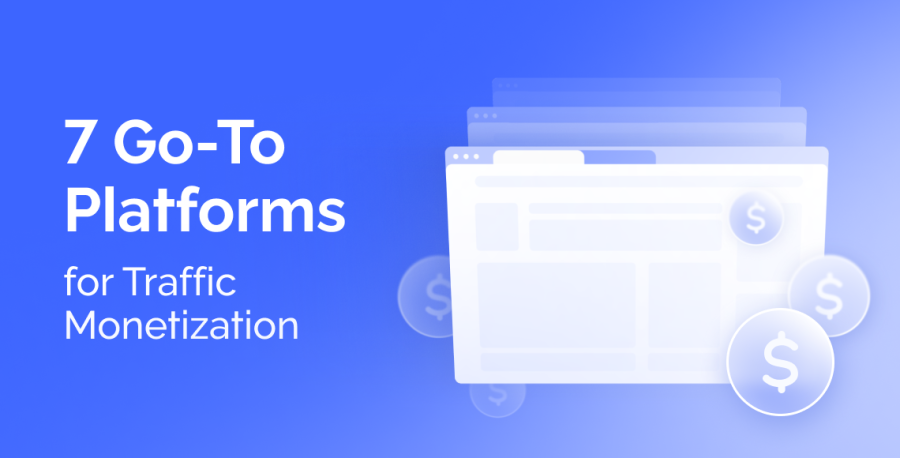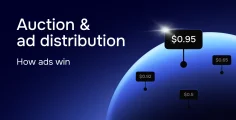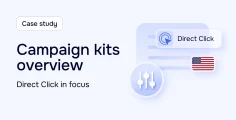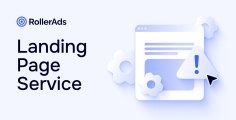A website is a powerful asset in the right hands; and a popular website is a veritable treasure. However, you need to know your buyers to get the best deal. And this is where monetization concerns come to the limelight.
As a website owner, or publisher, you generally let advertisers display ads on your website or page to make a profit. Most of the platforms support that approach, but there are other ways to make a living. Besides, ads differ in terms of quality, quantity, and character.
With this in mind, we present you with the following article, where you’ll learn about some of the most popular platforms to monetize your website. We’ll go through their pros and cons and explain which methods are the most reliable.

Traffic Monetization Explained
Monetization of traffic is a straightforward process: you need a web resource (like a website) and some people interested in it. If users frequently visit a particular website, it can be monetized, meaning the user’s interest can be converted into revenue.
Typically, it involves displaying ads for third parties in exchange for a payout, with the revenue increasing in proportion to the number of ads shown. Depending on how exactly the ads reach and affect the users, there are various traffic types:
- Paid: Social, PPC, Influence
- Free: SEO, ASO, Direct
- Junk or trash: Incentivized, Bots, Fraud
Traffic types can also differ by vertical, presence of adult content, ad formats used, and some other factors. If you own a website, we assume you’re primarily interested in paid traffic. You help advertisers promote their goods and services by allowing them to use your website for advertising. However, advertisers have various rates and terms, meaning it’s best to conduct research before partnering with anyone.
RollerAds Ad Network
RollerAds is a global ad network specializing in whitehat verticals, with you in charge of which content from the vast ad pool you choose to promote on your website. When it comes to ad formats, you can opt for classics like Push notifications, Pop ads (OnClick), and Direct Click.
RollerAds also cares for your SEO and can provide a customized strategy specifically for your website (if desired) to help your content rank higher in Google Search and appear on Google Discover through push notifications. With RollerAds’ push strategy, users consistently return to your website, prompting Google Discover to notice the trend and feature your articles or posts in its feeds. Being featured on Discover is great, because you can generate so-called organic users, marked by their exceptional level of engagement. Advertisers will give an arm and a leg to tap into this source of traffic, meaning you can earn more.
Moreover, RollerAds is compatible with other networks, so if there’s another ad format you are willing to try, you can test the waters with other platforms to multiply your earnings.
Getting started with RollerAds is easy; simply sign up as a publisher, upload your website for moderation, and add a few lines of code to your website to connect your user base to the platform’s infrastructure.
It doesn’t matter where you’re from or which language your audience speaks, as RollerAds has worldwide coverage. You can also enjoy a convenient range of payout providers and withdraw your earnings any way you want. There’s also a referral program, which complements the already high rates by offering 5% of the earnings generated by each referred webmaster.
Google AdSense
The most prominent ad formats on Google AdSense are Banners, Native, and Video ads. AdSense is convenient because it leverages Google’s infrastructure. However, bans there are permanent, and payouts tend to be delayed.
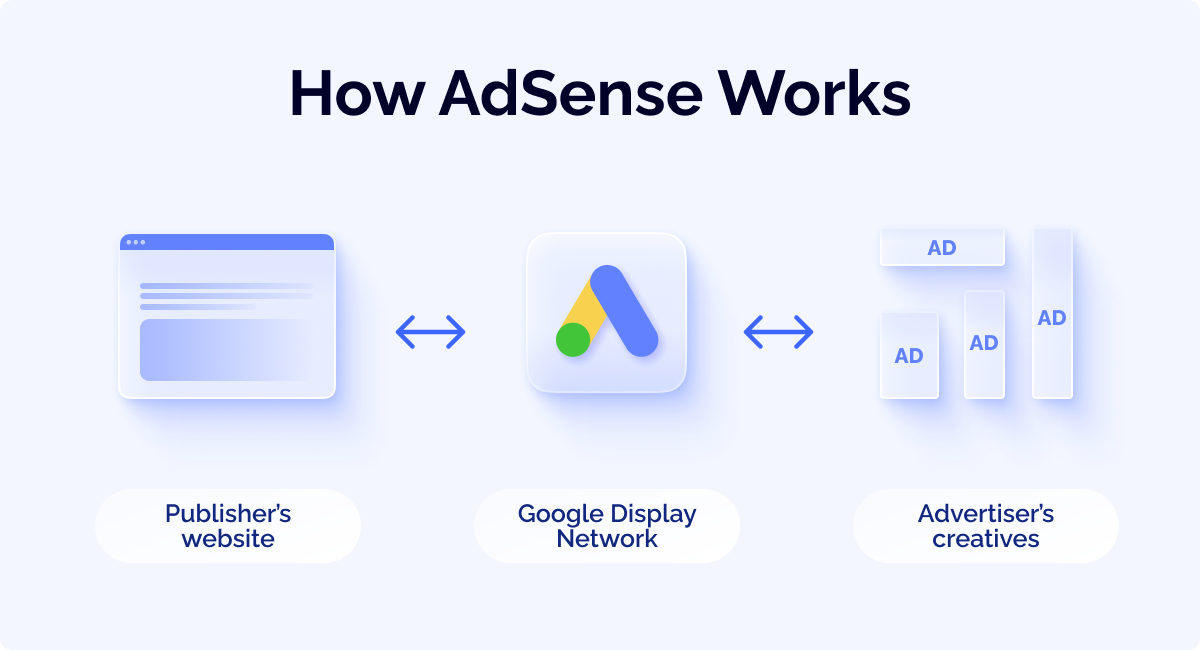
Furthermore, this monetization platform supports neither Push notifications nor Popunders. However, when you couple AdSense with RollerAds’ features, you can create a synergy that will attract more users, enable you to retarget them more effectively, and increase your ad exposure.
Long story short, your website can support more than just AdSense ads simultaneously. When users get to your website, you can subscribe them to RollerAds’ push notifications. What makes them special is that you can display more than just ads, mixing things up with news, updates, and quick reminders—it’s called Hybrid format.
The idea is that users never know what the next Push notification brings, so they tend to open ads more often. If you use push notifications to inform users on top of displaying ads, they’ll have fewer reasons to unsubscribe because of the genuine value of such messages.
Subscribed users might leave your website (and stop receiving ads from Google), but push notifications can bring them back. Not only does this improve your website metrics, but it also enables you to retarget users and keep on displaying AdSense content regularly (meaning more money for you).
Taboola
Taboola is a digital advertising and technology company that serves as a discovery platform and connects users with content they may find engaging. This platform offers native ads, video ads, display ads, carousel ads, and app promotion ads.
Armed with Taboola’s range of tools, which include A/B testing, advanced reporting, and personalization features that boost user engagement and content performance, you are poised for success in digital media.
However, despite its strengths, Taboola has notable drawbacks. Being often associated with clickbait-style, it can harm a publisher’s credibility, particularly on professional or educational websites. Additionally, this platform primarily focuses on native recommendations and lacks other advertising options, meaning some of your ad space may be overlooked, potentially costing you an opportunity.
Outbrain
Outbrain, like Taboola, focuses on native advertising and delivers ads designed to match the look and feel of a website’s content. It offers a variety of formats, including image-and-text units, video ads, and short video clips.
While Outbrain can be a valuable part of your ad strategy, it may not be sufficient on its own to make the most of your website. Relying solely on this platform can leave specific ad spaces untapped and limit your revenue potential. For consistent and optimized earnings, Outbrain is best used in conjunction with other ad networks that offer diverse formats and higher revenue possibilities, such as RollerAds or Google AdSense.
Ezoic
AI is king. And Ezoic knows it better than anyone. This top-notch technology company and Google Publishing Partner helps website owners optimize monetization, user experience, and even site speed with the help of AI. The platform analyzes visitor behavior to dynamically adjust ad formats, placements, and sizes in real time.
Ezoic takes it a step further by using AI to generate video content and articles, making it easier for publishers to create engaging media.
However, relying solely on Ezoic has its limitations. Apart from lacking diversification opportunities, it operates on a revenue-share model unless you join their paid Premium program, which means you won’t retain 100% of your earnings.
Media.net
Media.net, a contextual ad network powered by Yahoo and Bing, can be a strong monetization option, especially for text-rich websites. This platform supports various ad formats, including display, native, and search ads, helping publishers generate revenue by matching ads to their page content.
Since Media.net relies heavily on contextual advertising, it may underperform on pages with limited text, generic topics, or non-English content, which can reduce its effectiveness in certain niches. It also primarily targets Western markets such as the U.S., U.K., and Canada. As a result, sites with a majority of traffic from regions such as Asia, Africa, or South America may experience significantly lower earnings.

Infolinks
Infolinks offers publishers a way to monetize their websites through advanced native ad units, including InFold, InTag, InText, InFrame, and InArticle. Designed with higher revenue streams in mind, these formats blend seamlessly into the content, enhancing its overall appeal. By targeting unused or less visible ad space, Infolinks helps maximize a site’s monetization potential.
One of the key advantages of Infolinks is its flexibility—it can run alongside platforms like Google AdSense, making it an ideal supplementary income stream rather than a full replacement.
However, customization options for styling and ad placement are somewhat limited compared to more advanced monetization platforms. And while it can boost earnings, Infolinks is generally best used as a secondary monetization tool due to its lower revenue potential and fewer controls.
Final Thoughts
Traffic monetization platforms are many, and so are ad formats. For optimal use of your ad space and maximum earnings, consider platforms that offer a 100% fill rate of your inventory or diversification options.
By combining several platforms with different ad formats, you can significantly boost your website’s revenue and even improve SEO if you choose the right partner.
That’s where RollerAds comes in. Register as a publisher now—it’s completely free, both financially and in terms of liability. With RollerAds, your website will generate consistent revenue, enjoy improved SEO, stay protected from reputational risks, and remain entirely under your control. Moreover, RollerAds experts are always ready to help. Whenever you need assistance, don’t hesitate—your dedicated manager or support team is just a message away.

